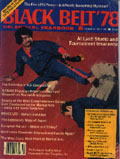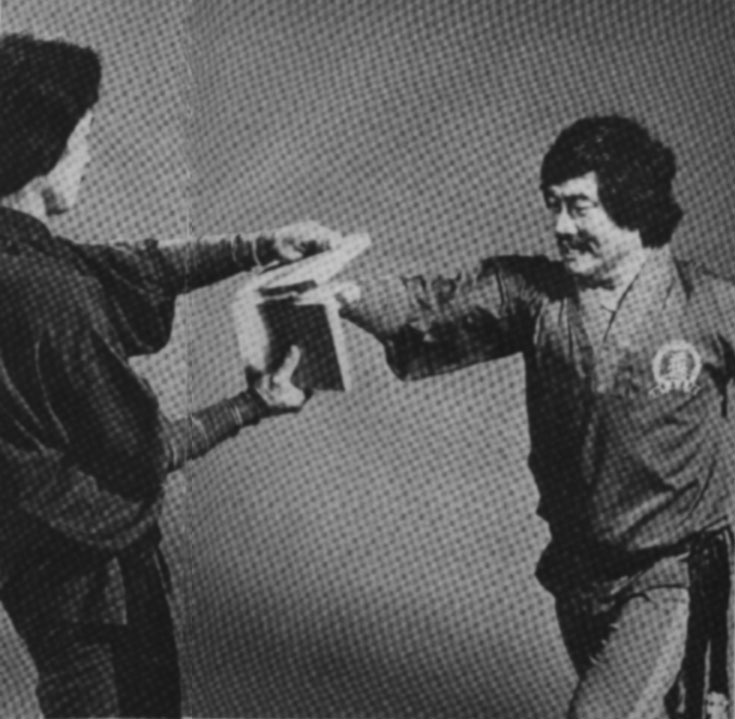- Is it really something mystical?


 Photo Caption: Demonstrating ki, one finger of Joo Bang Lee snaps through
solid wood.
Photo Caption: Demonstrating ki, one finger of Joo Bang Lee snaps through
solid wood.
It's been described as feeling "hot." Starting in the lower abdomen, it burns as though fire is coming up through the body, separating into both hands. That was the way Joo Bang Lee, founder of hwarangdo, described the physical sensations he experiences while performing techniques with ki power, the one aspect of training and conditioning sought after by most martial artists yet perhaps understood the least. For virtually everyone who performs outstanding feats of strength or dynamic breaking techniques claims to utilize some form of internal power. And though there are a variety of cultural names used to describe it, this power is most commonly referred to by the Korean term, ki.
Comprehending the difference between martial artists who utilize ki power and those who do not can be as ponderous as trying to understand the ki power concept itself. For it is as physicists describe electricity - you can witness, monitor and measure the effects, but you still cannot define precisely what it is. About this analogy of electricity and ki power, Joo Bang Lee was in total agreement. And though he is a recognized leader in the area of ki, one gets the impression that even he is hard pressed for ways of describing what is possibly the most elusive aspect of the martial arts.
Because answers about the exact nature of ki can be no better
than the questions probing the phenomenon, the interview with Lee focused upon
his perception of the process, location, types and uses of ki in hwarangdo.
Almost from the start, he emphasized that in its traditional approach, hwarangdo
is primarily a combat martial art.
"It must be understood that hwarangdo is, in no way, a sport," he said. "Traditionally,
you never move back, you never retreat in the face of the enemy. There are only
two ways a hwarang warrior is trained - win or die. So to use the art, to even
teach it today at a level anywhere near its full potential, would be against
the law -in most instances.
"As a result, control is very important. So we teach the art as a means of control
over any situation without using excessive force in punching or kicking. It
is taught mostly to adults as a means of control with the hands."
Asked what he considers the most important aspect in gaining
an understanding of ki, Lee said it was the importance of developing the stomach.
"The power comes from techniques of breathing in and out from the stomach, not
the lungs," he said, touching his abdomen, continuing that three inches under
the navel is where this breathing becomes focused.
"There are governing meridians," Lee said. "One meridian goes from the top of
the head down and the other comes up from the bottom of the back. When a person
has developed ki power, you can have this internal feeling of the energy transmitting
straight through so that the two meridians are connected."
Saying he actually feels a form of energy flowing within him, Lee continued
that the average person uses 40 percent of his energy capacity. But through
development of ki power, the hwarangdo practitioner can use 100 percent. And
though this process is primarily physical in nature, he was quick to emphasize
that the mind plays an important part.
"People who are mentally tired or mentally handicapped are not capable of developing
ki power," he said. "Most people, however, are capable of outstanding demonstrations
of ki during extreme situations."
Giving the familiar example of the auto accident in which a
mother suddenly found she had the strength to pick a car up off her baby, Lee
said the woman was able to lift it without even thinking it was impossible.
Motivation for the energy came about primarily as a result of fear for the life
of the baby. But the energy was achieved with mental concentration, after which
the energy wore off.
"This is uncontrolled ki," he said. "Martial artists use controlled ki. And
in hwarangdo training, we develop ki power, reserve it and then use it at will
whenever necessary."
In attempting to describe the actual process of using controlled
ki, Lee said his mind evokes a picture to protect an area of his body, such
as his stomach, when he performs demonstrations where a motor vehicle is actually
driven over him.
"I'm thinking only of protecting myself and of nothing else," he continued.
"I automatically control whatever part of my body is going to sustain the weight
so there will be no damage."
For some people, the anticipation of pain can be greater than the actual pain
experienced. So Lee was asked if there were ever a moment when he was about
to have someone drive a vehicle over his stomach, before which he suddenly found
himself questioning whether or not he could actually go through with the demonstration?
"Then you die," he said with great authority. "You have to think you can do
it. This is important because if you have any self-doubts, you can get hurt.
And if you're not positive in your thinking about the situation, you'll never
make it."
Anytime he has ever had doubts whatsoever, Lee said, he has not attempted a
technique.
In combat situations, ki power may be useful not only in terms of attacking with increased strength, but also in terms of a more effective defense. The body is capable of going into a state of ki in less than a fraction of a second, Lee said, so an advanced ki developer can automatically generate the energy throughout his body to instantaneously repel an impending kick or punch. In addition, the practitioner may focus the control of ki in several different parts of the body with what is called the "whole body developing force," allowing him to simultaneously repel kicks and punches from several different directions.
Just as the hwarangdo practitioner often directs his attacks
towards his opponent's center of ki, he also faces the possibility of having
his own center of ki injured. Because this can happen, Lee said, we have a series
of techniques designed to make the body numb to pain.
"So even though there is a chance that someone attacking me may knock me out
before I have a chance to utilize ki power, the cure is very easy," he said.
"For the control is then achieved by sitting down and healing yourself."
Lee said he once healed himself of a broken foot. And though the pain was great
for about 10 minutes, he was able to subdue it, allowing him to set the bones
which then healed on their own within a three-month period.
"It is our contention that a true martial artist must have the
ability to heal if he has the capacity to kill or injure," Lee said in answer
to the question, Is a hwarangdo practitioner given instruction in how to treat
the injuries he may inflict? "Fifty percent of our instruction is in the Oriental
healing arts of acupuncture, acupressure, herbal and natural medicines, as well
as bonesetting."
Lee said it is actually possible to transfer the energy of ki from the hand
of one person to the painful or injured part of someone else's body and effect
healing.
"That's where the spirit goes out," he said, looking at the palm of his hand.
"When I give my whole energy to people, the palm of my hand turns purple because
there's a lot of blood in that area until the condition subsides a few minutes
later."
So the hand that possesses almost superhuman strength for killing quickly also
possesses what may turn out to be superhuman strength for healing. This is probably
the most fascinating and compelling aspect of ki power in the ancient art of
hwarangdo, the mechanics of which we are only now beginning to explore.